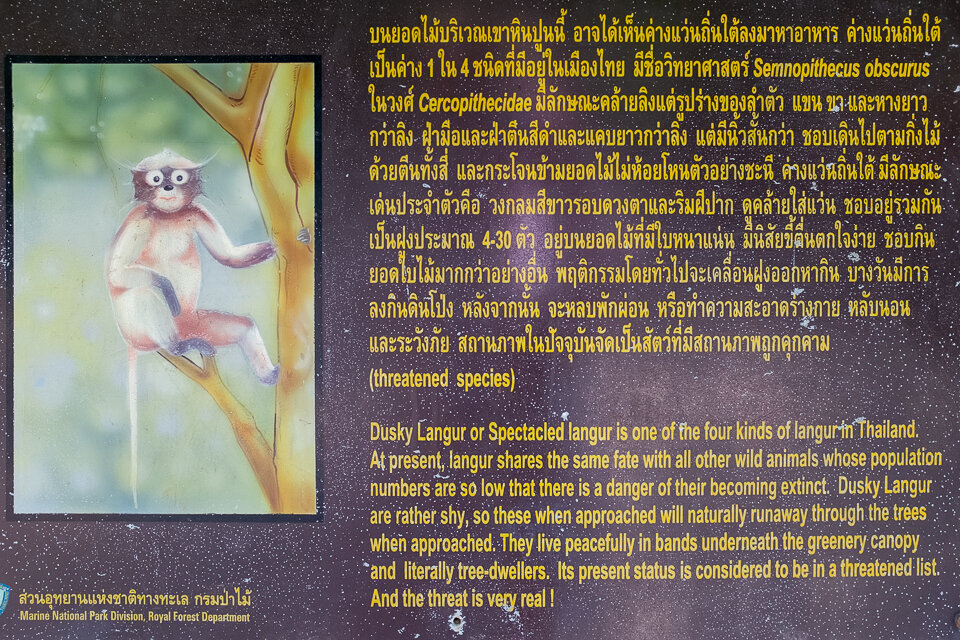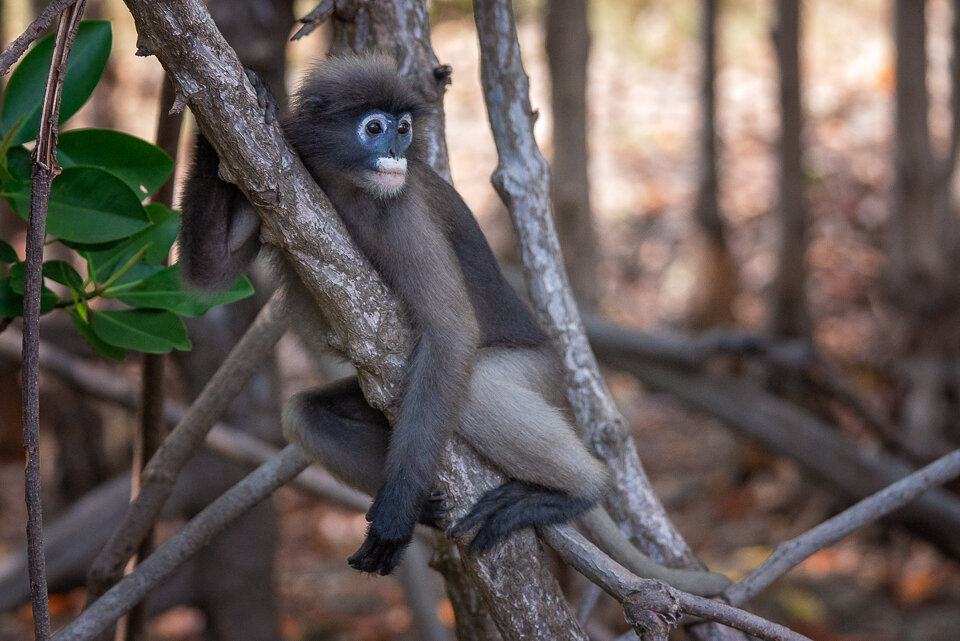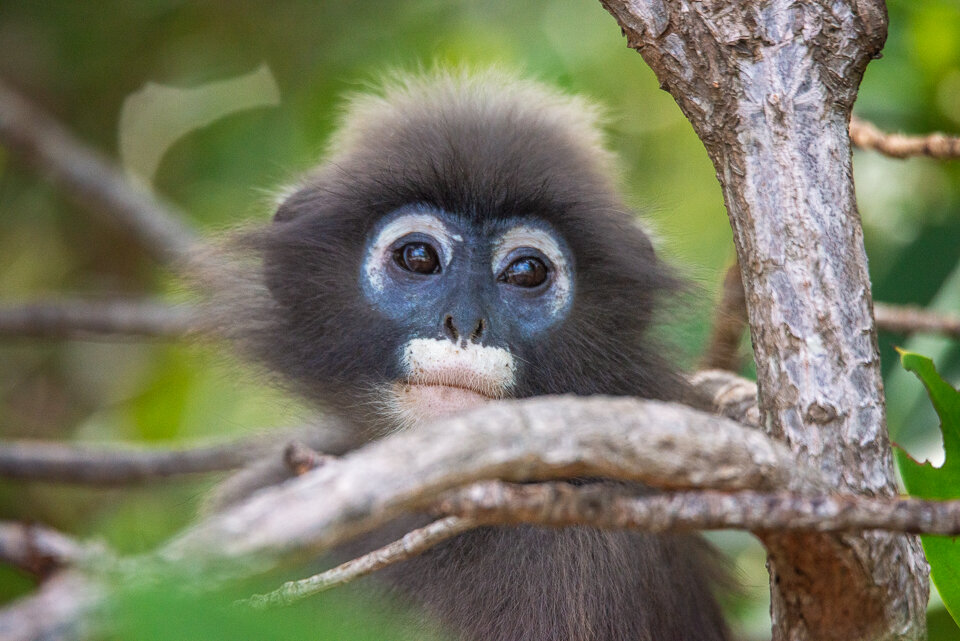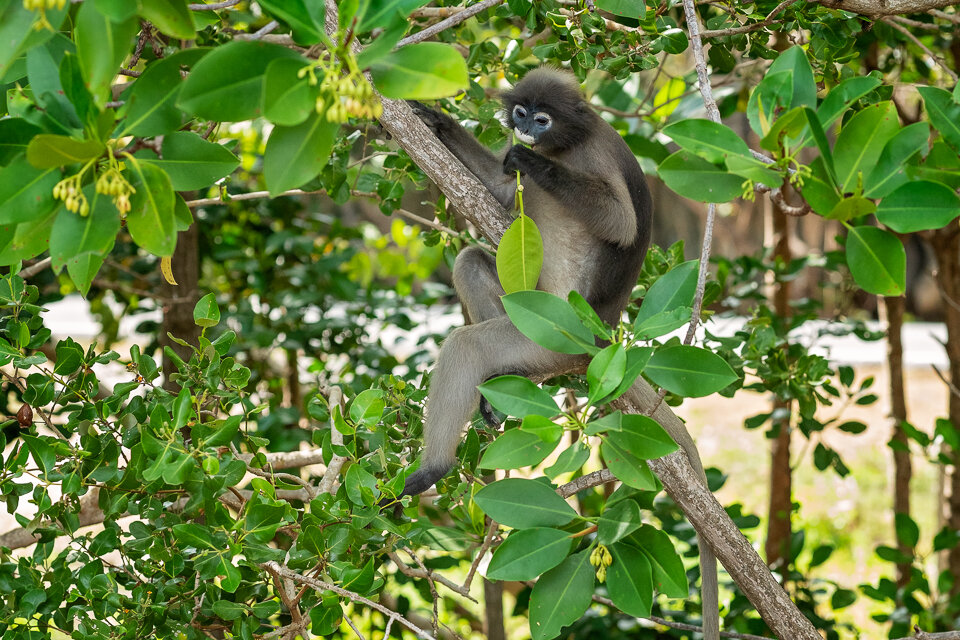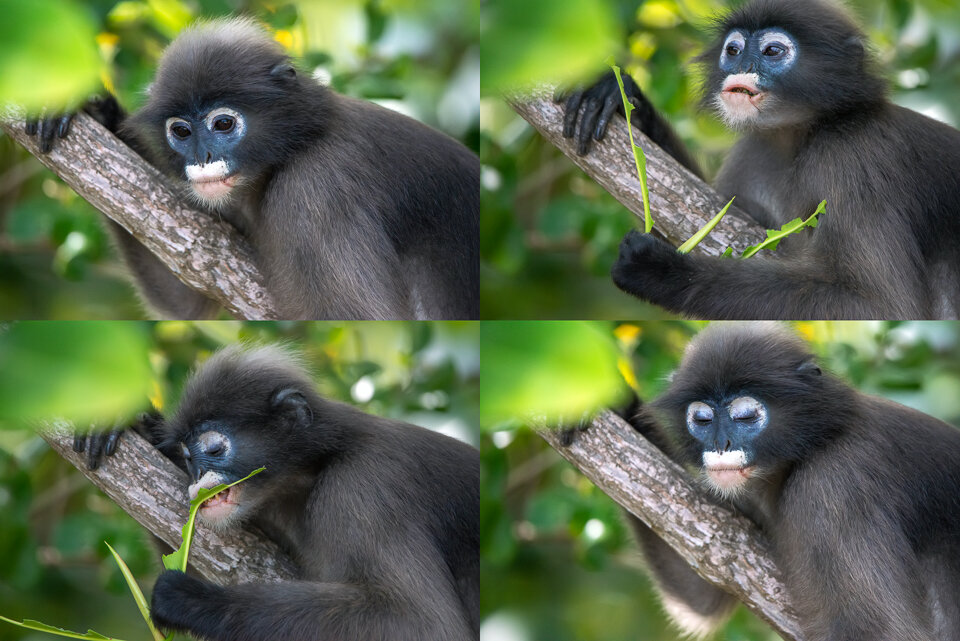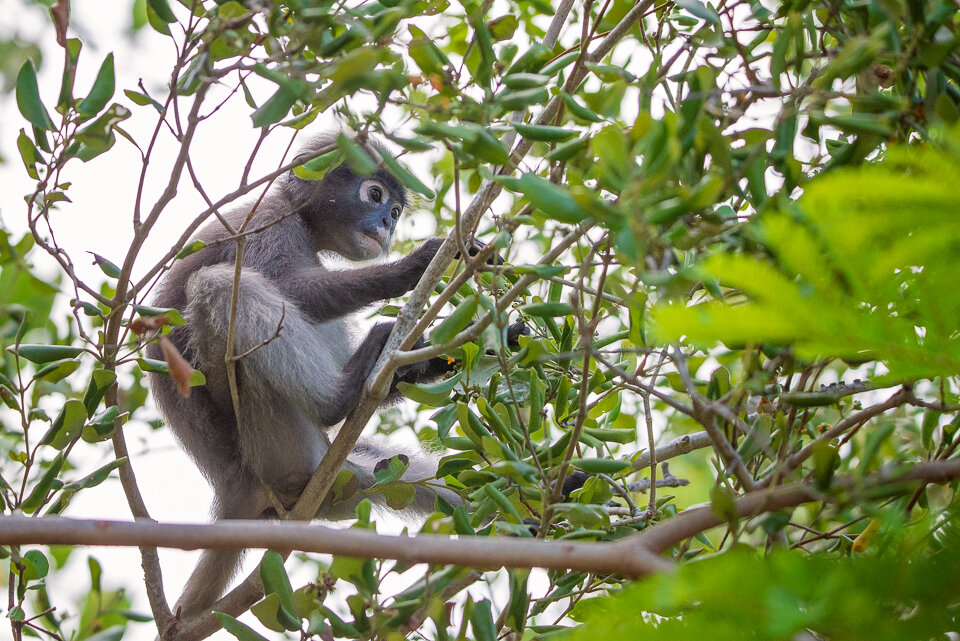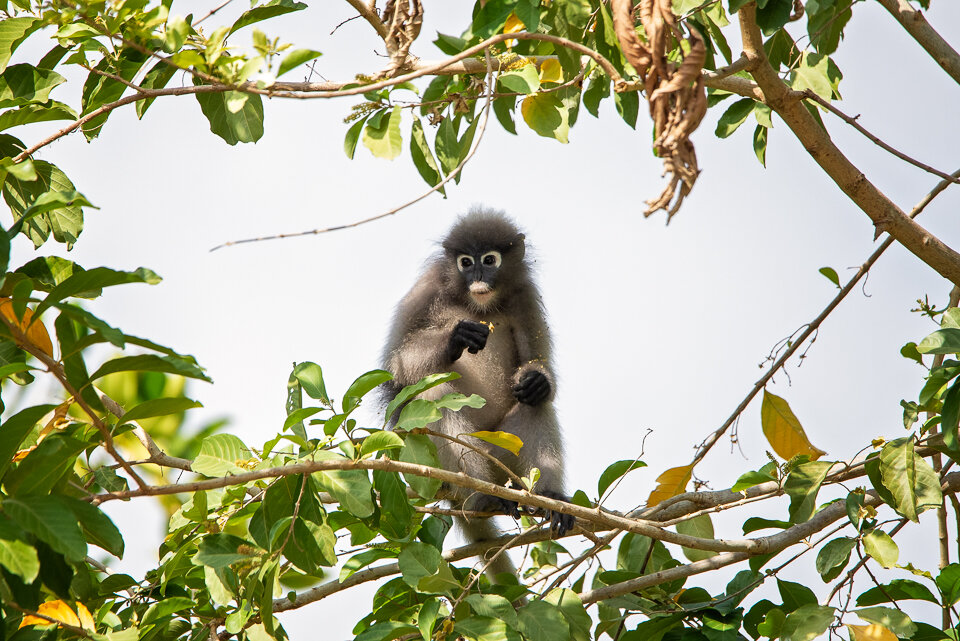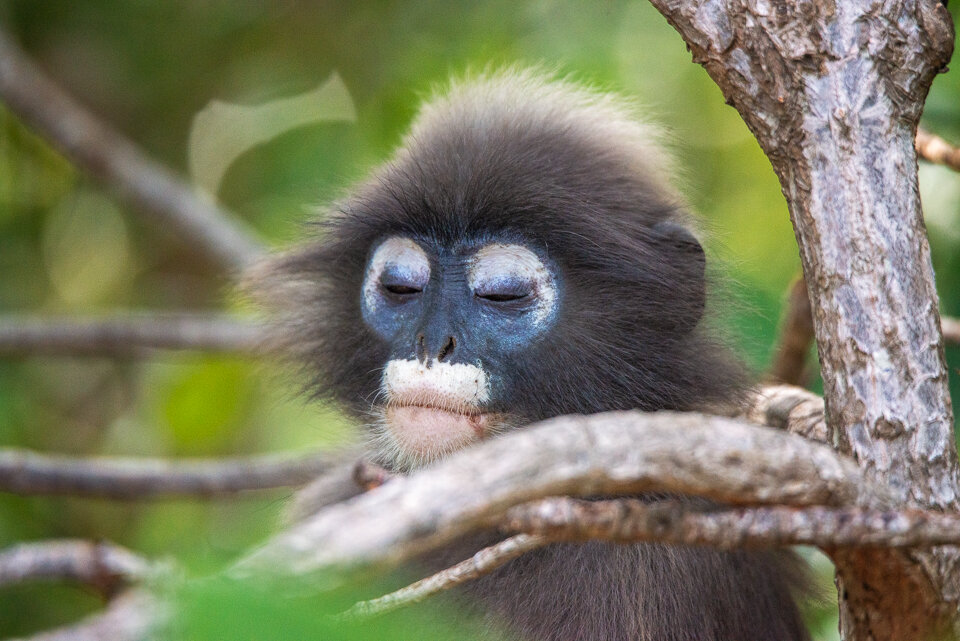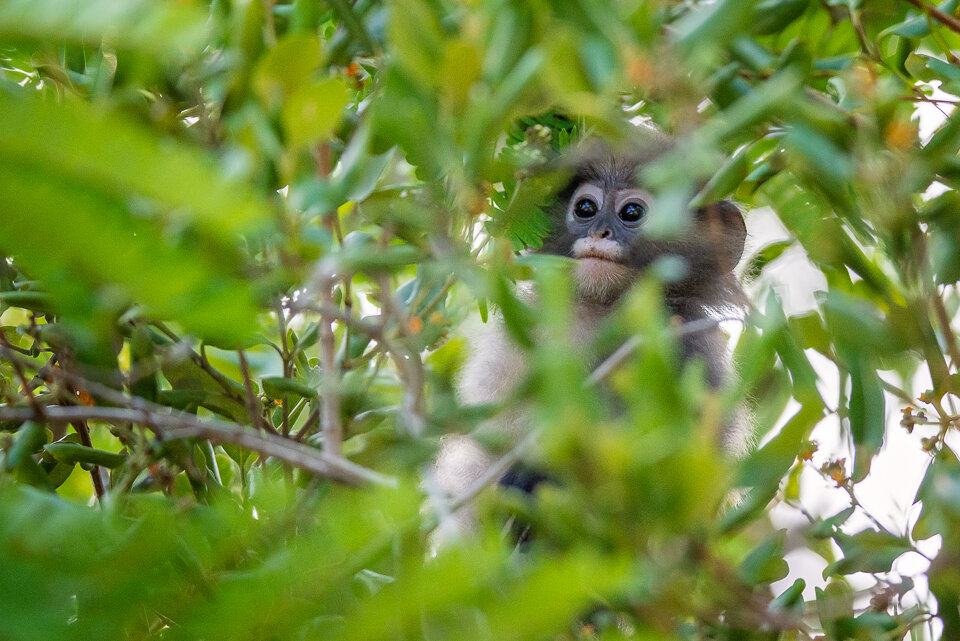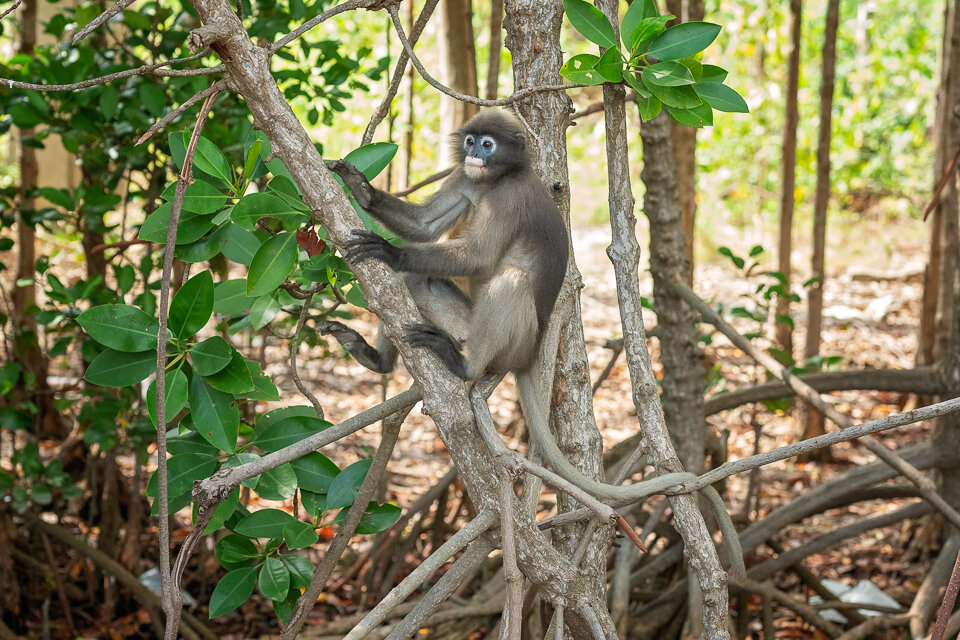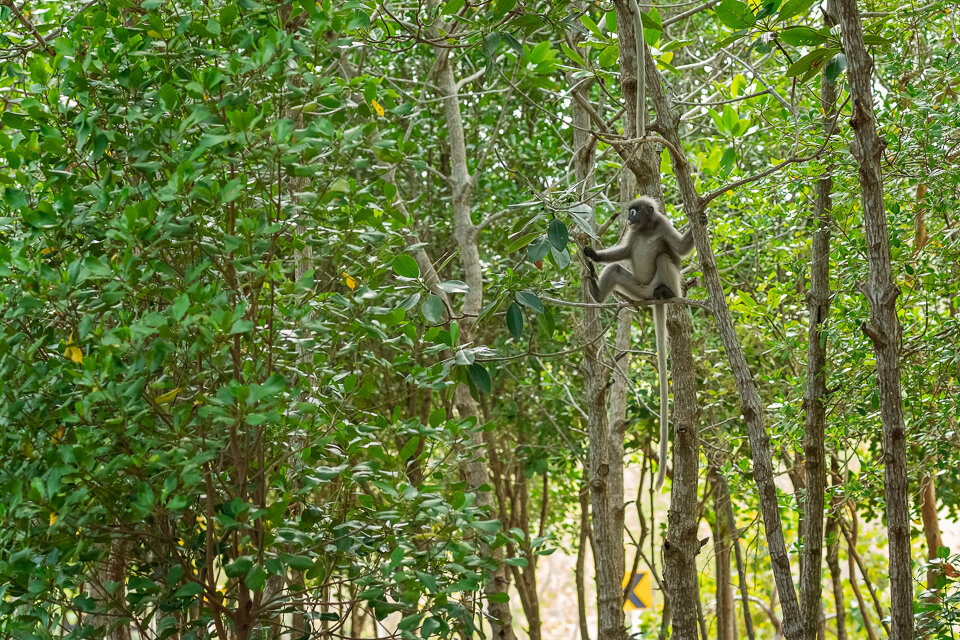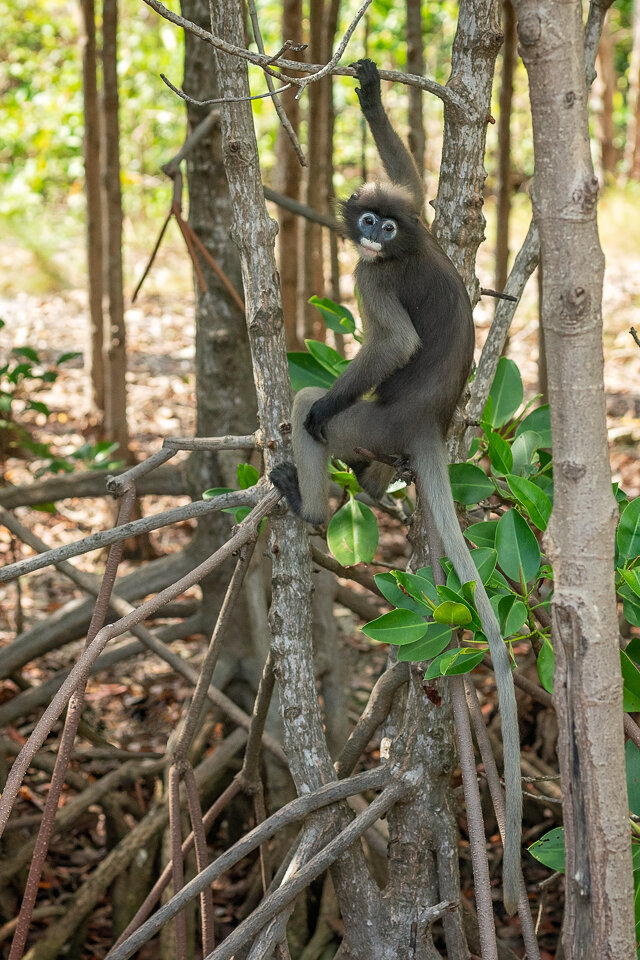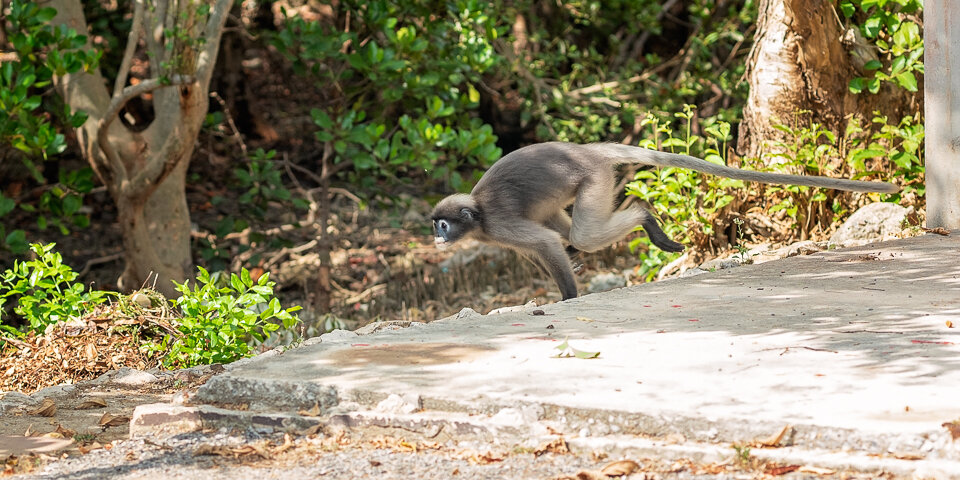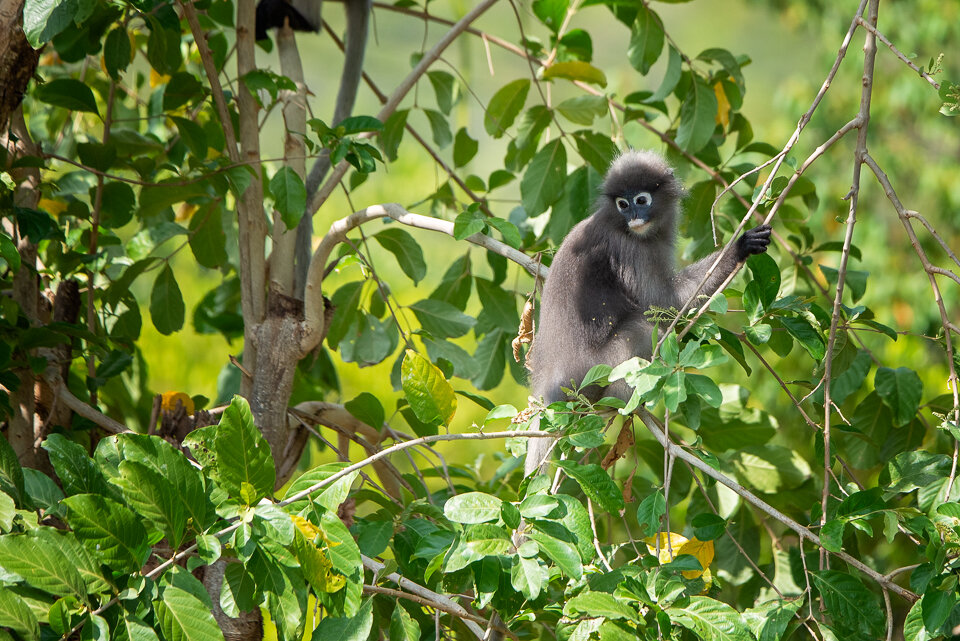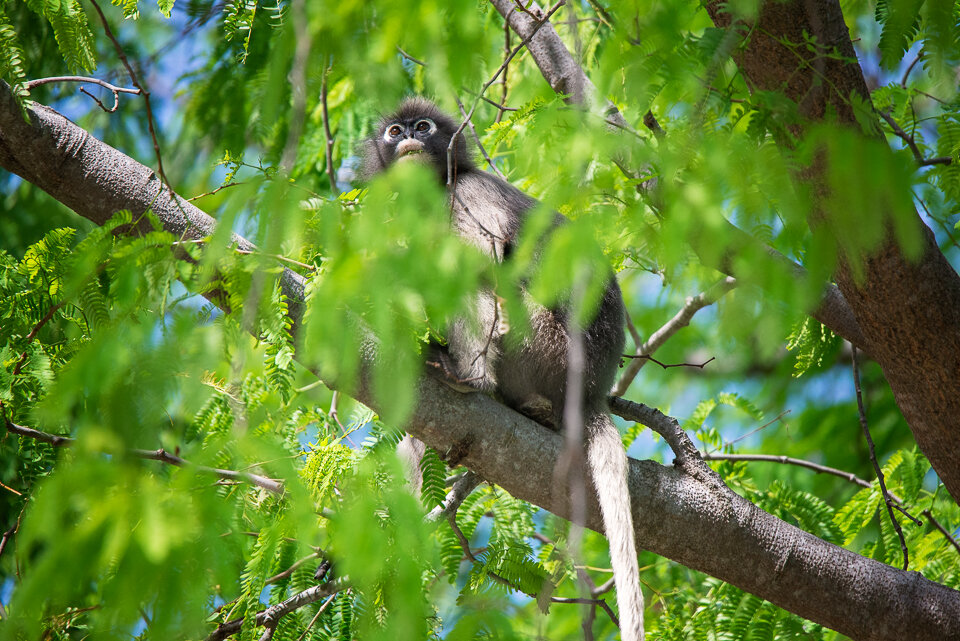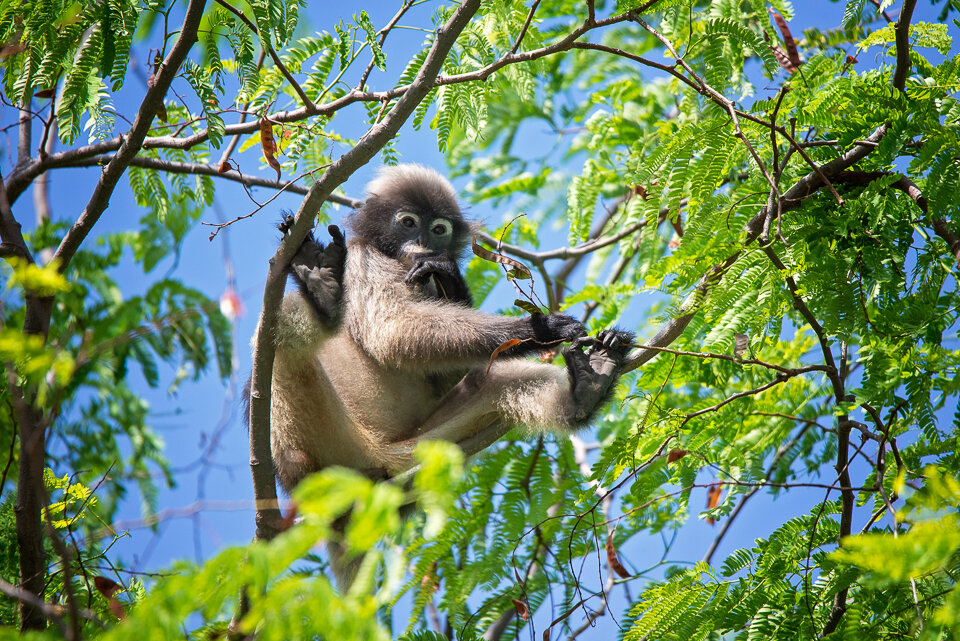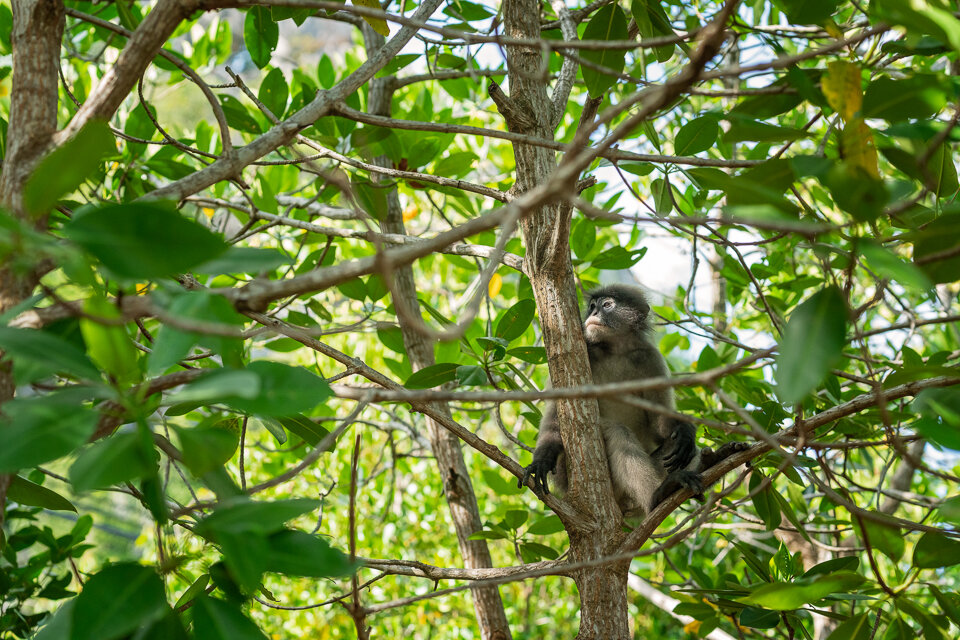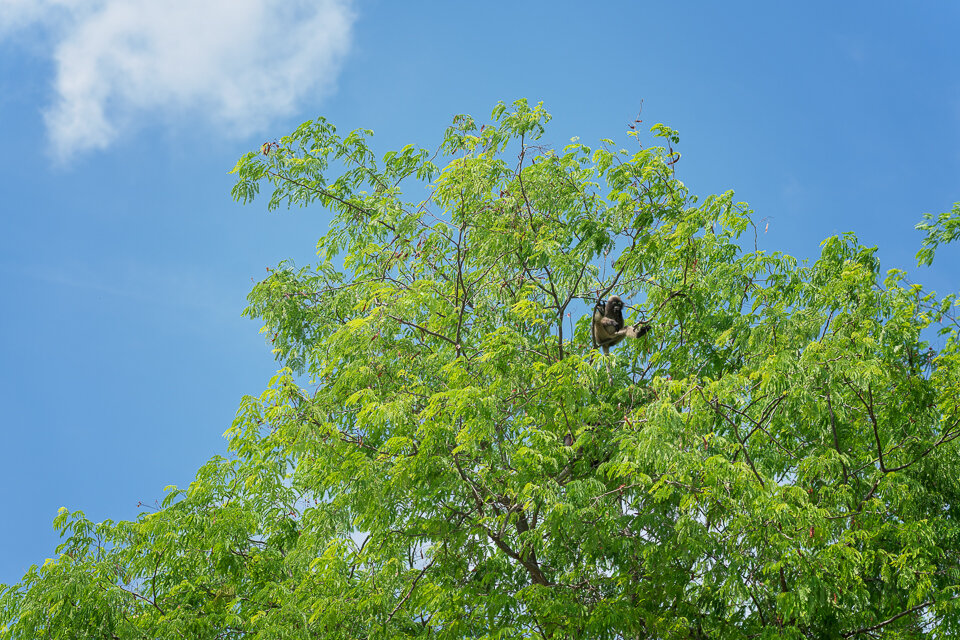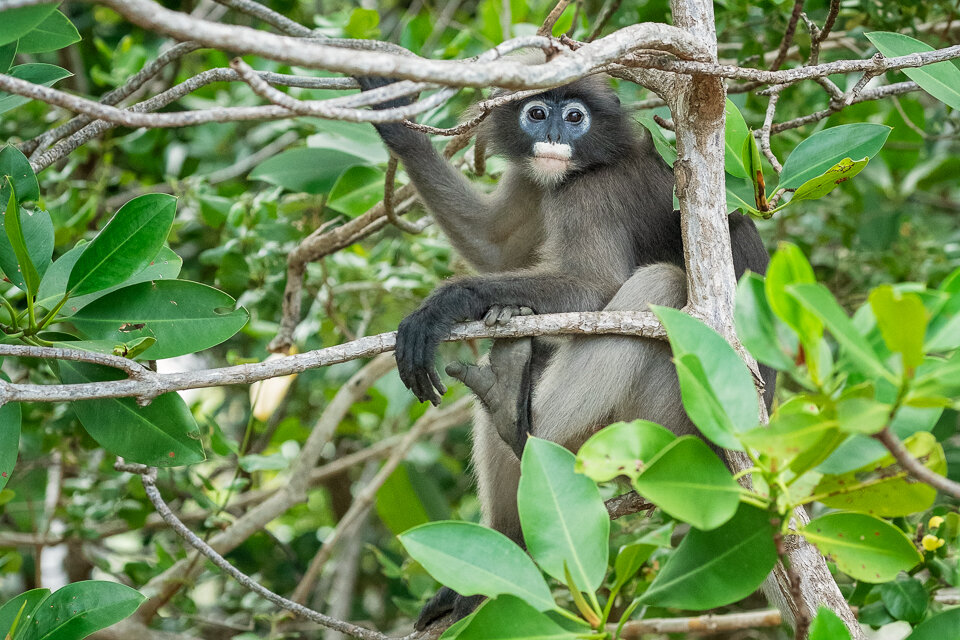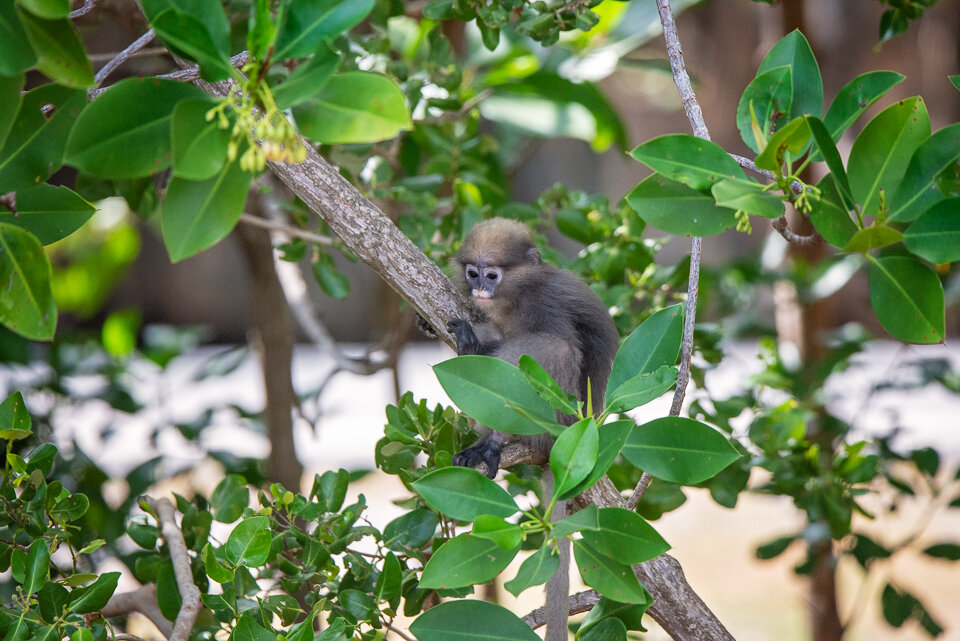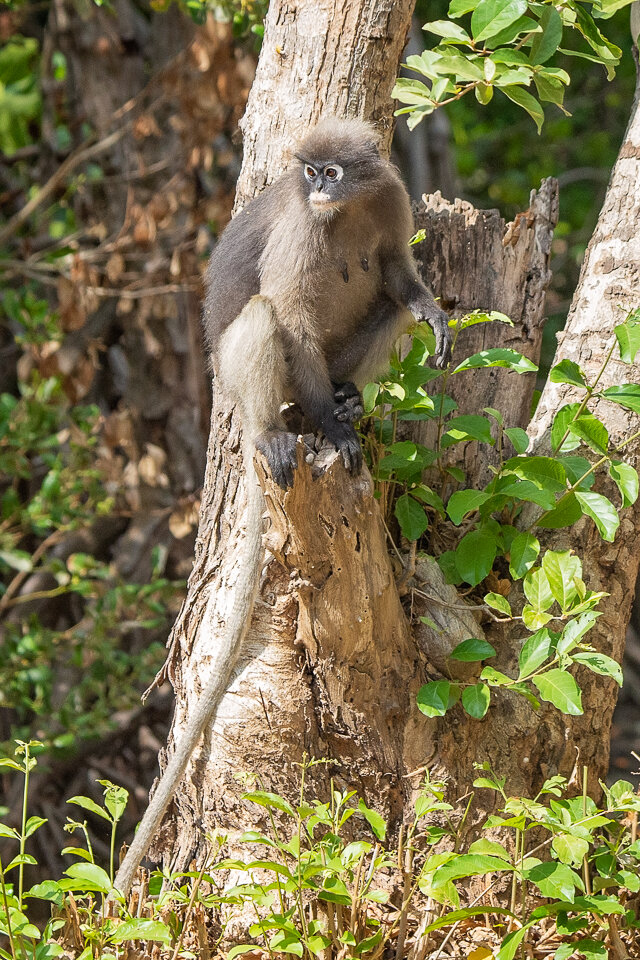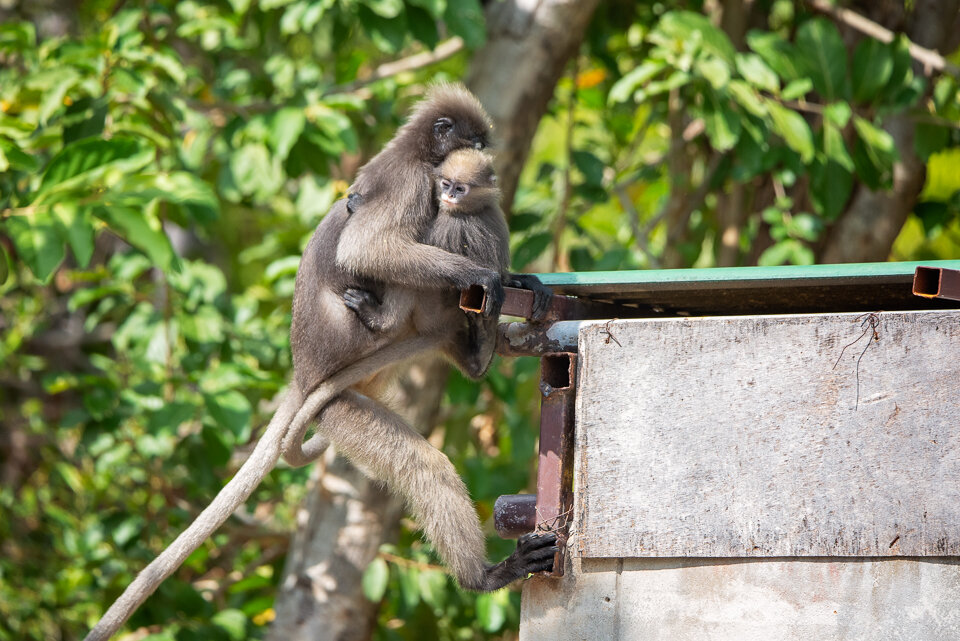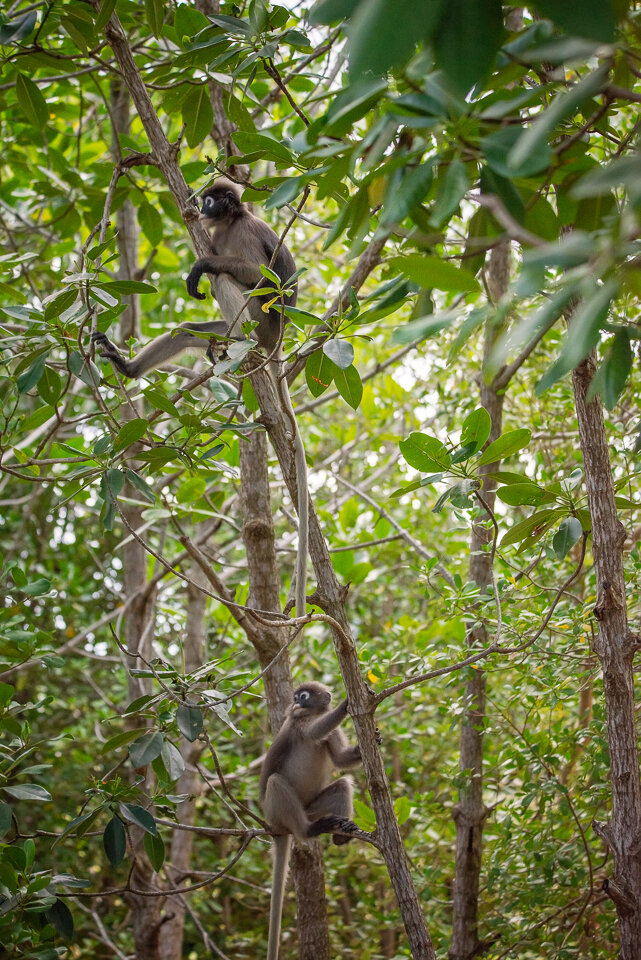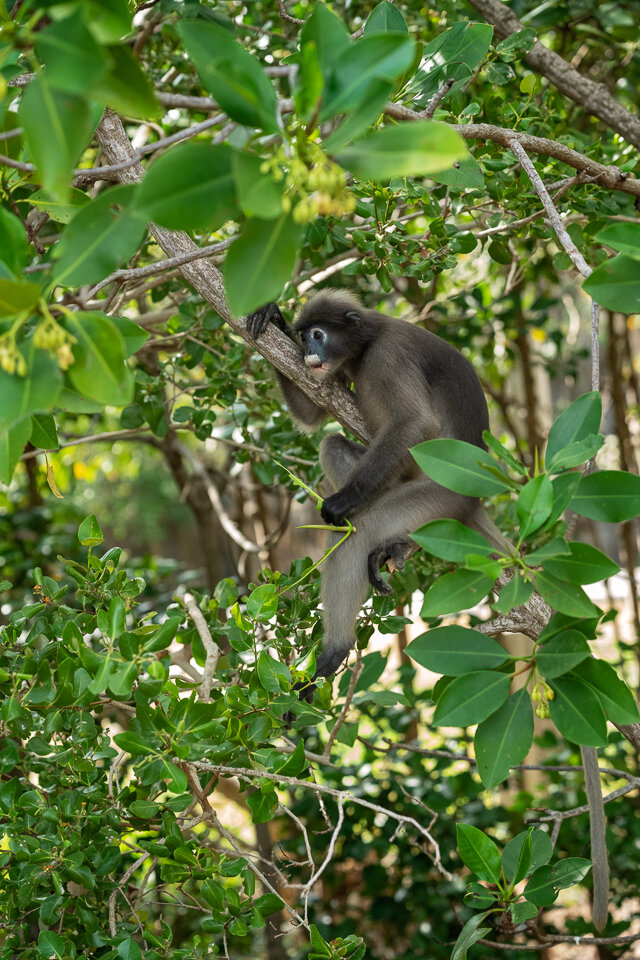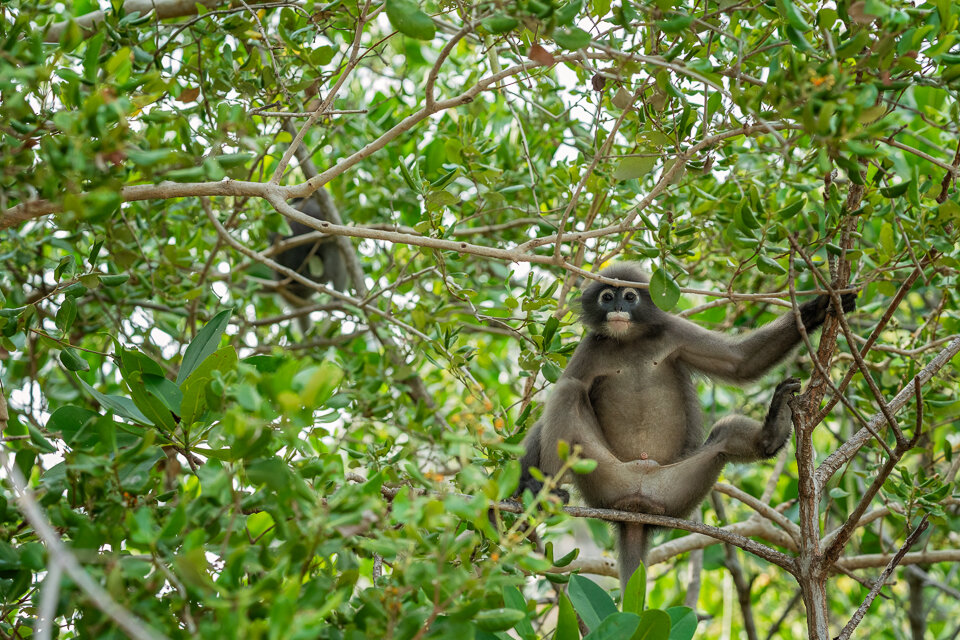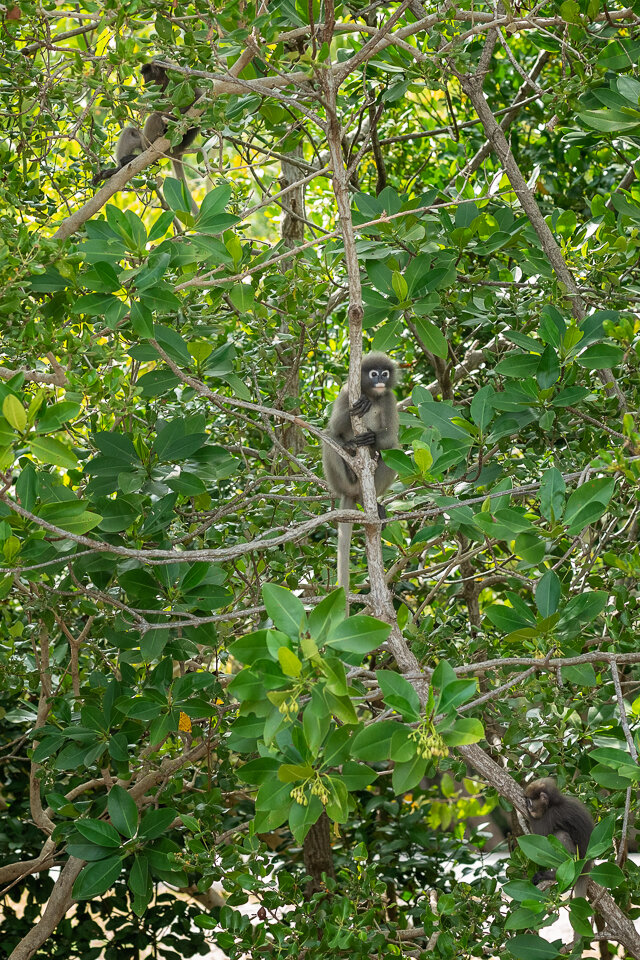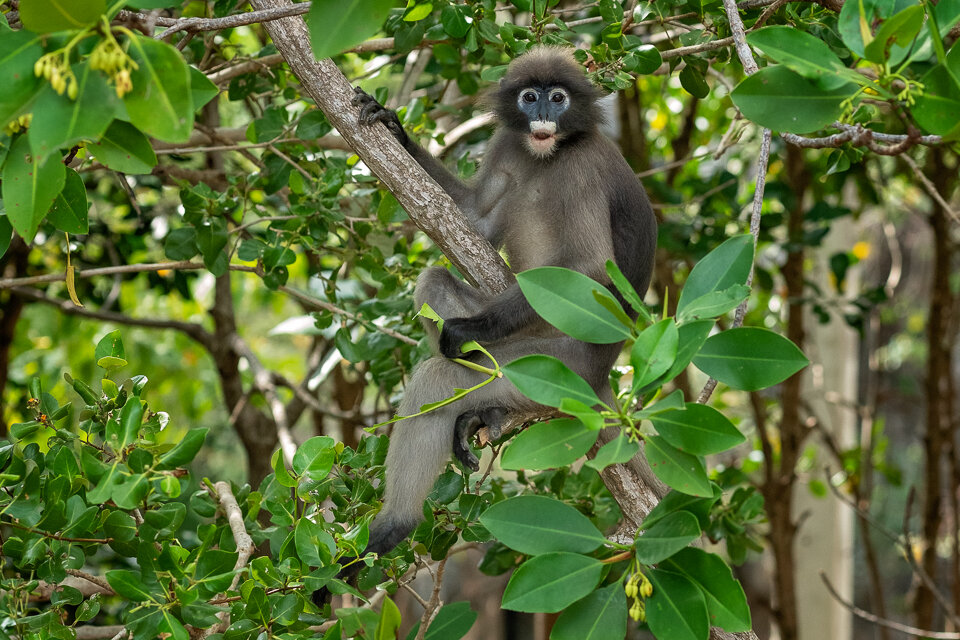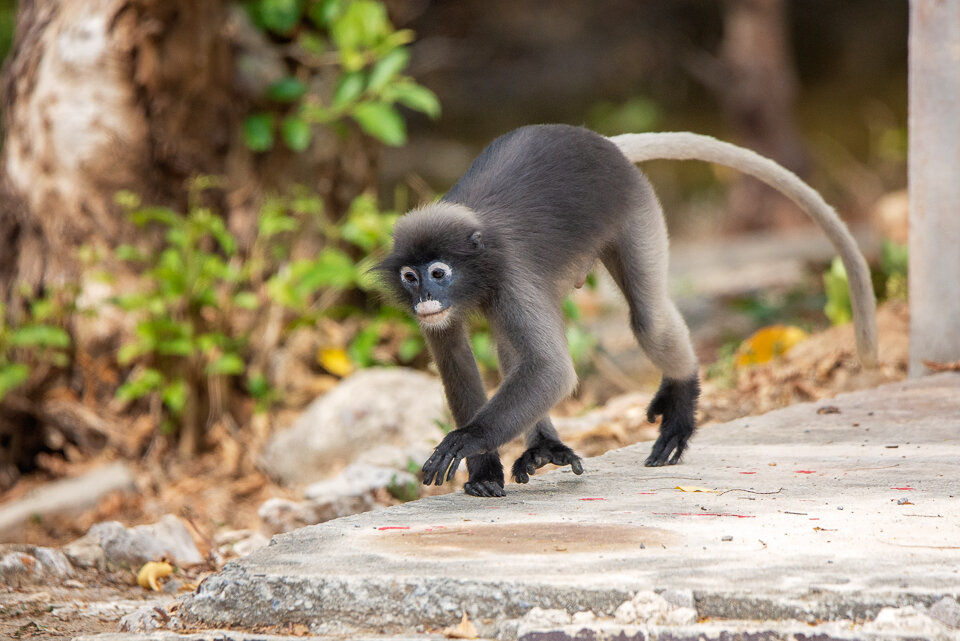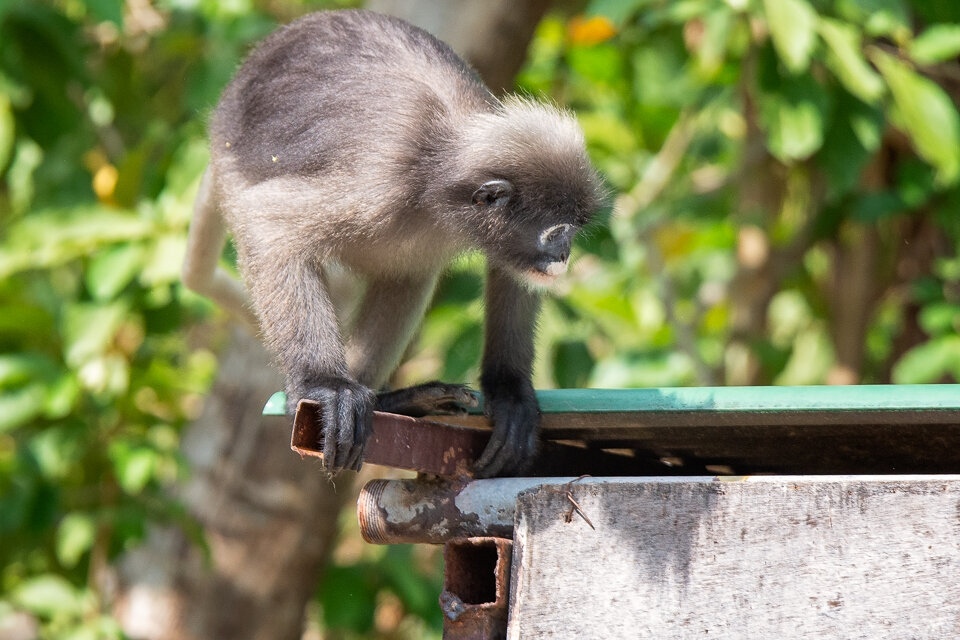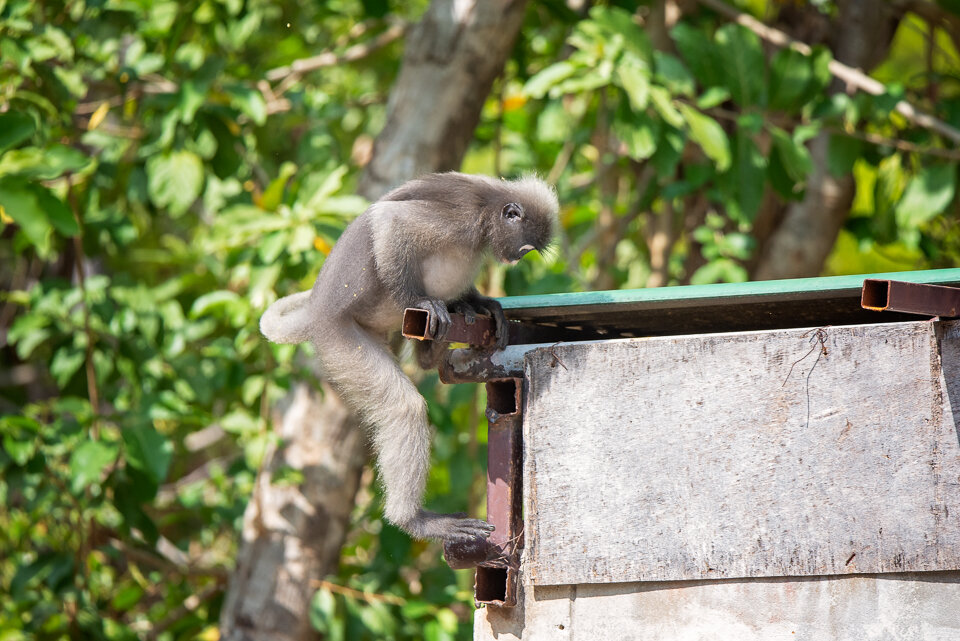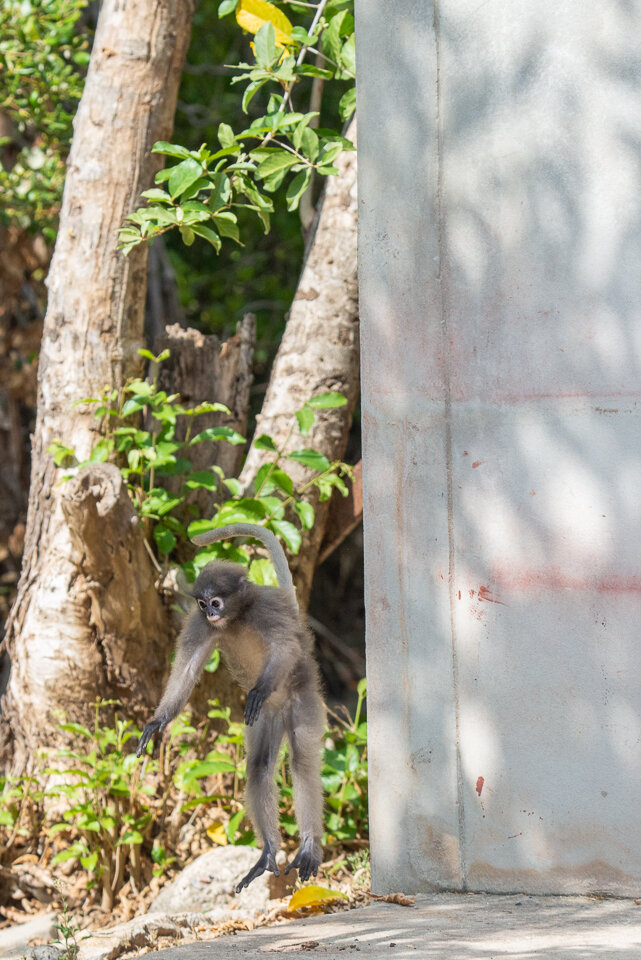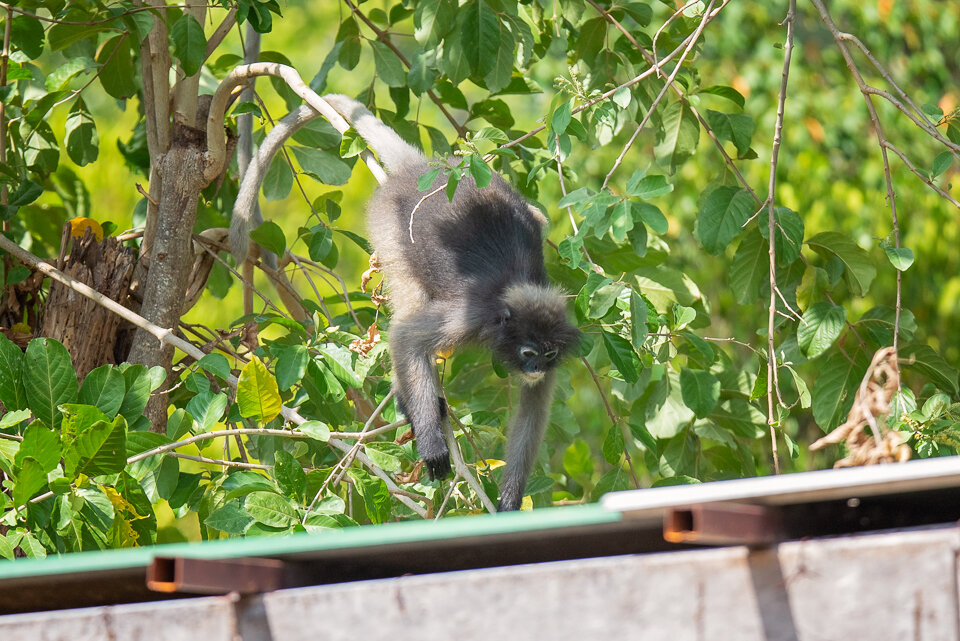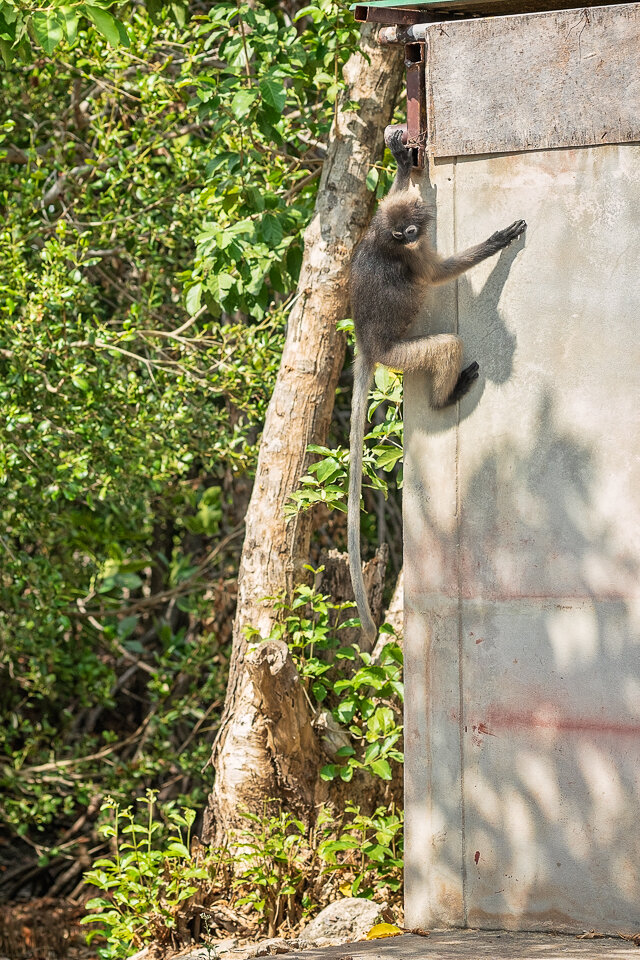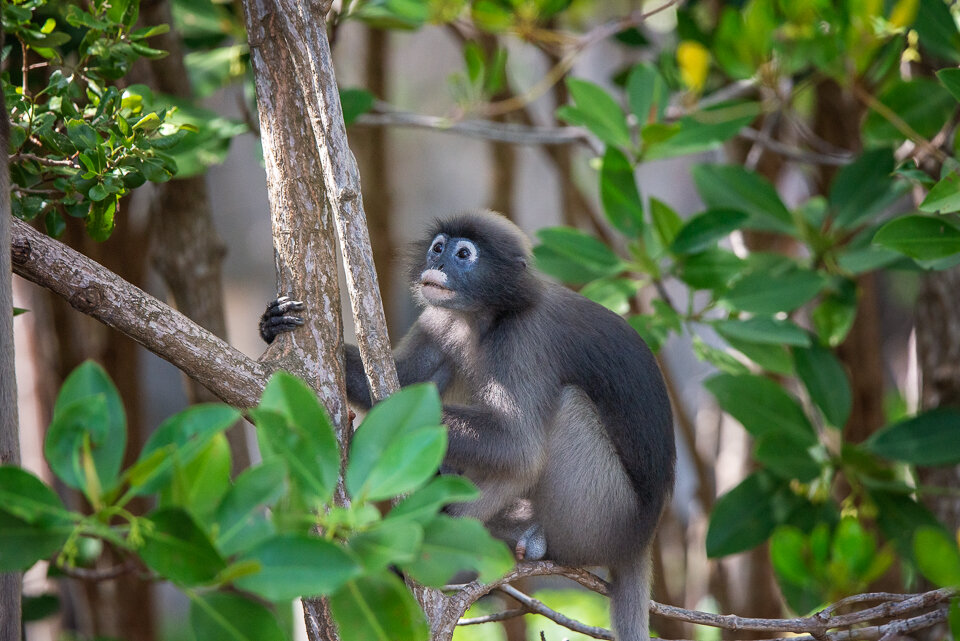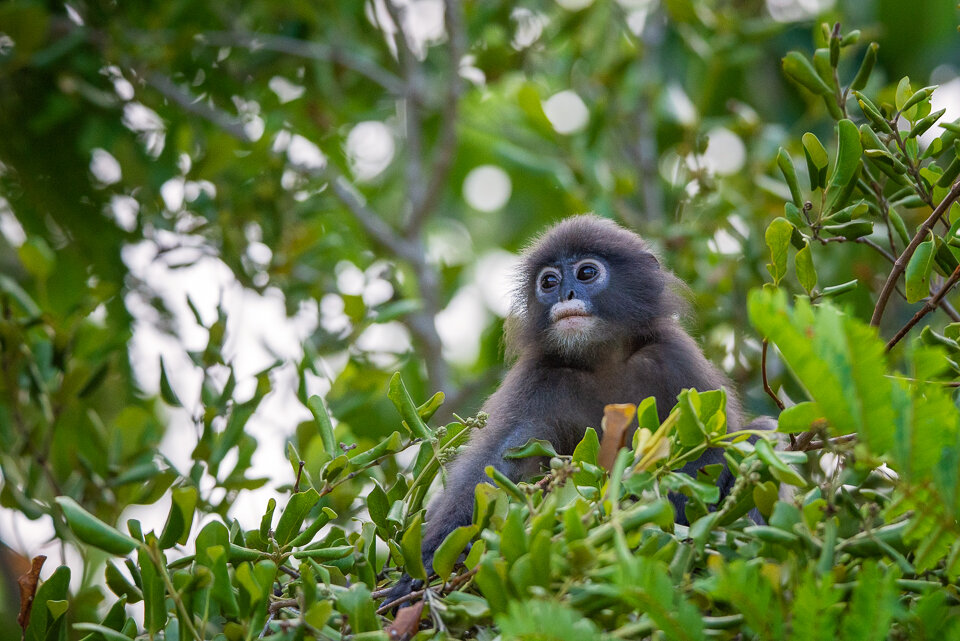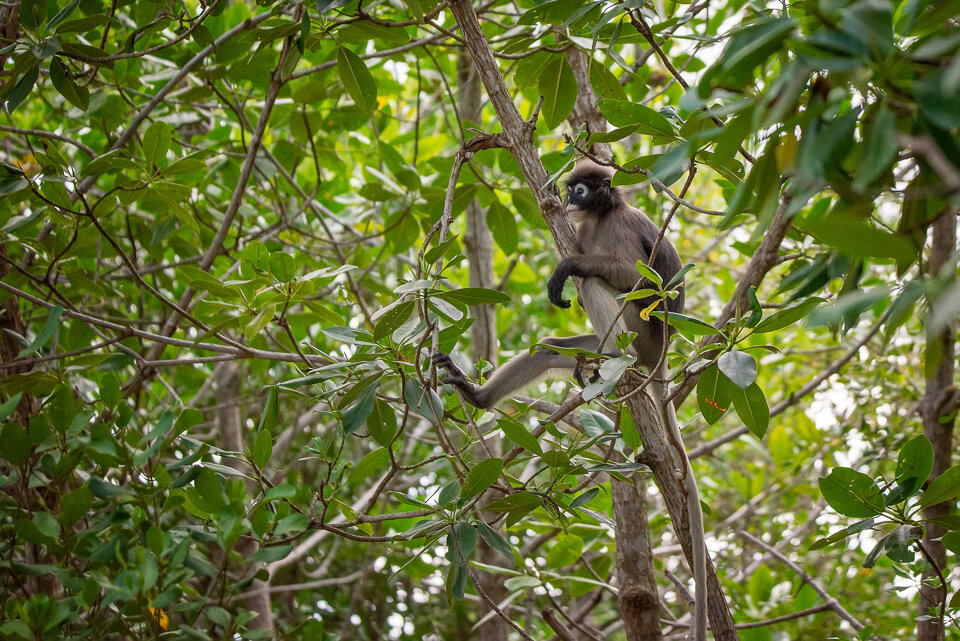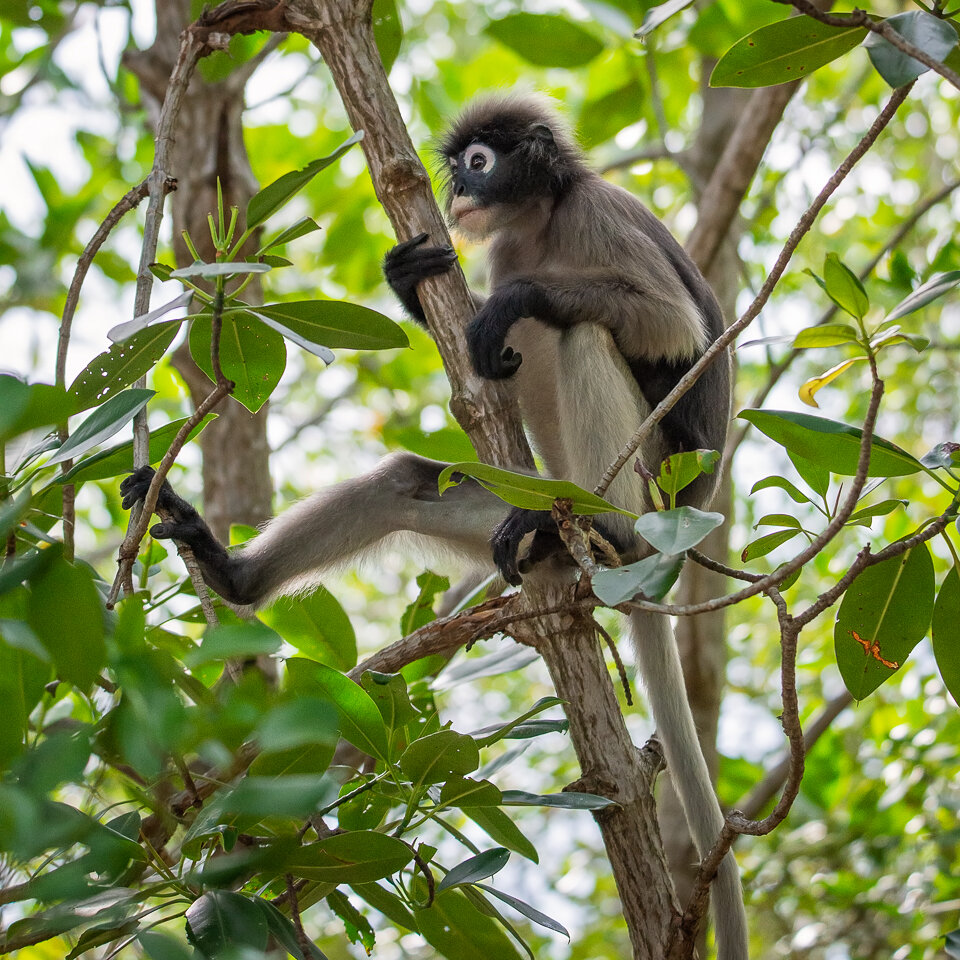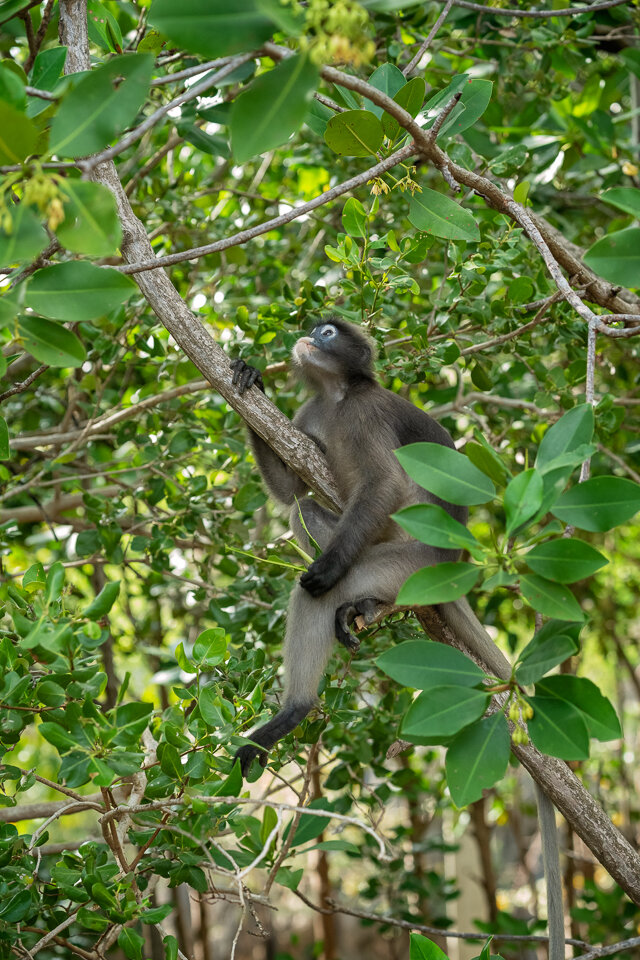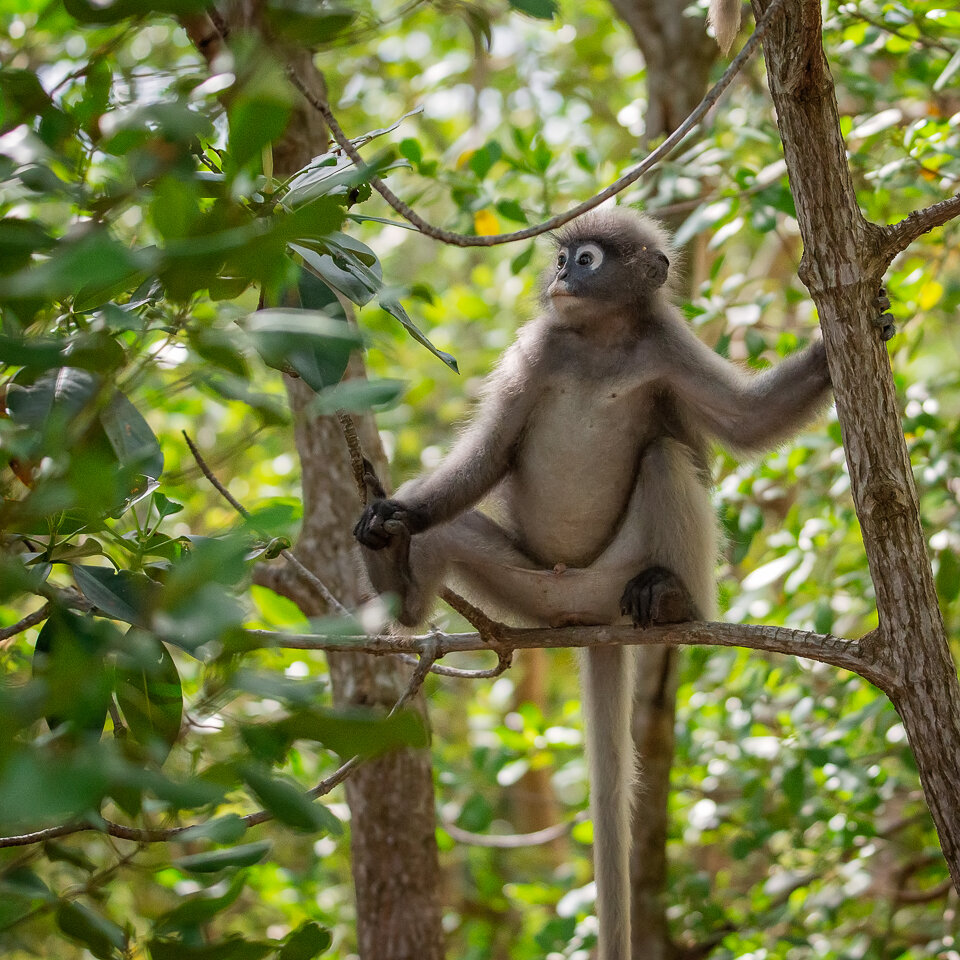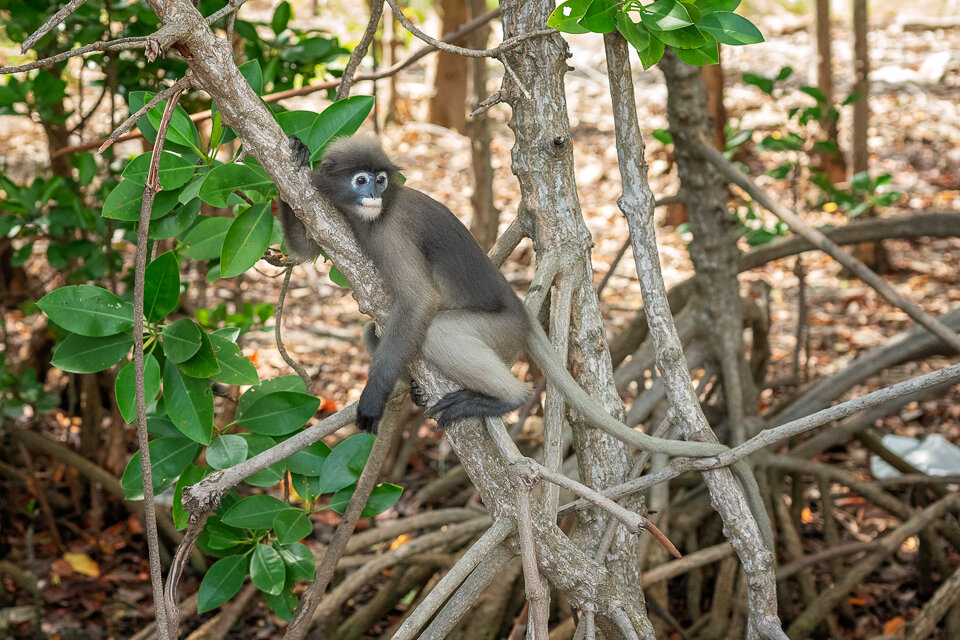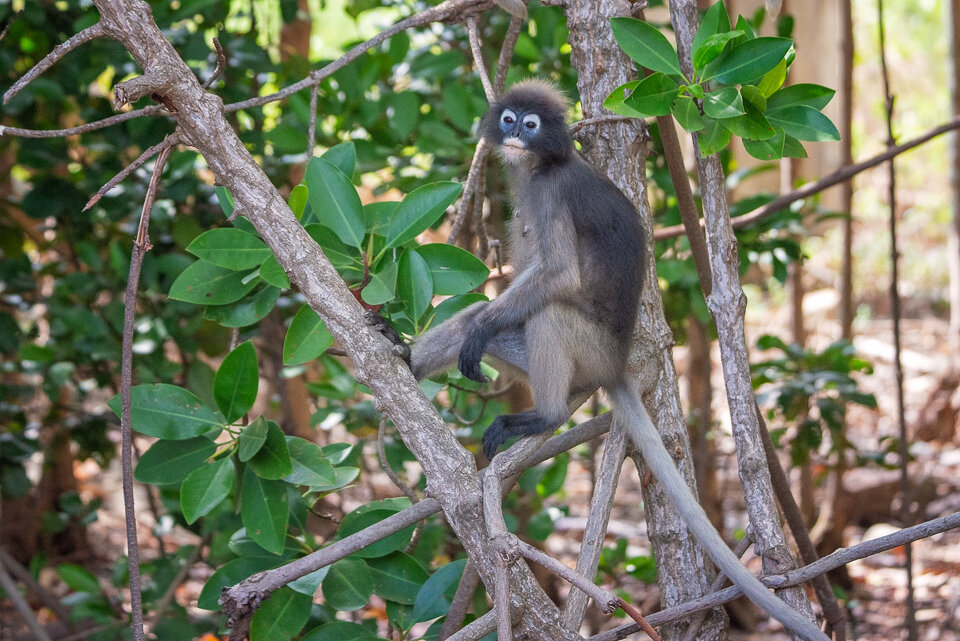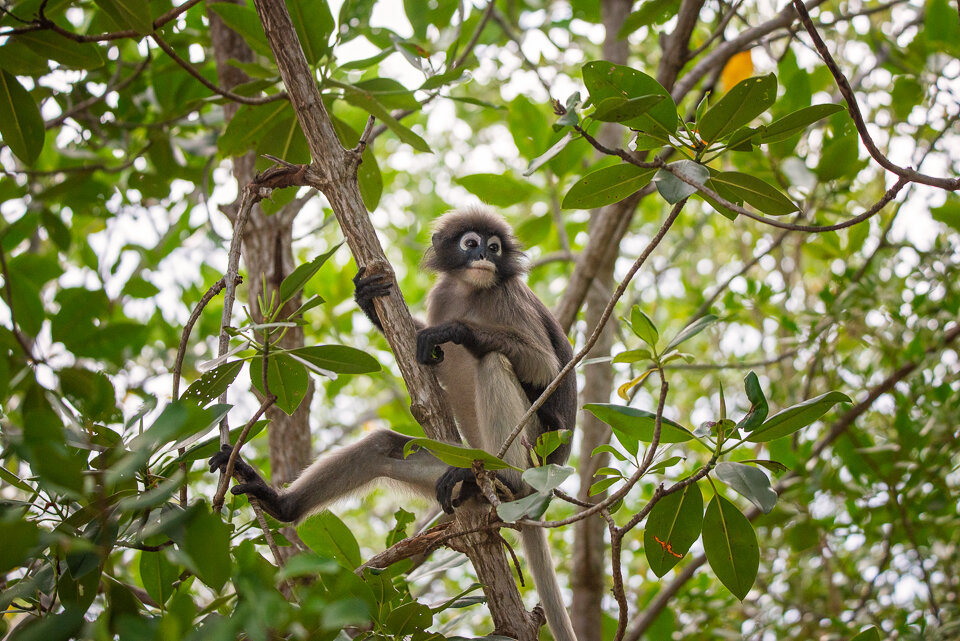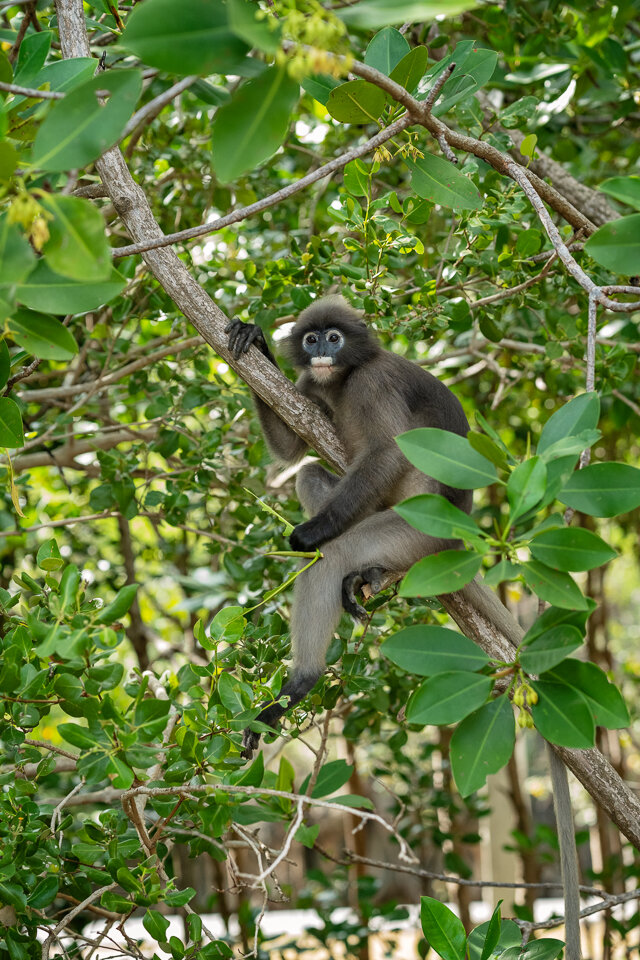They do deserve a few words, so here we go. Our new friends are Dusky Langurs (Trachypithecus obscurus), sometimes also called Spectacled Leaf Monkeys. The word “langur” is derived from a Hindu word which means long-tailed. Langurs belong to a family of primates known as Cercopithecidae, or Old World monkeys. The family is divided into two subfamilies; the Cercopithecinae, which includes the baboons, macaques, mangabeys, and guenons, and the Colobinae, which includes the leaf-eating monkeys.
Wymyśliłam sobie wcześniej, że po polsku langurs to langury, a tymczasem okazuje się, że to są lutungi. Napotkane przez nas tutaj, w Tajlandii, to lutungi ciemne (Trachypithecus obscurus). Angielskie słowo „langur” pochodzi od hinduskiego słowa, które oznacza długi ogon. Lutungi należą do rodziny naczelnych znanych jako Cercopithecidae (kokoczodanowce) lub małpy Starego Świata. Rodzina podzielona jest na dwie podrodziny; Cercopithecinae (koczkodanowate, makakowate), która obejmuje pawiany, makaki, mangabki i koczkodany oraz Colobinae (gerezy), która obejmuje małpy liściożerne, w tym lutungi.
Langurs have a high fibre diet, which consists mainly from leaves but can also include unripe fruits, bark and blossom. They are capable of consuming 2kg of food every day. This food is slowly digested by the Langurs unique gut flora. They have a specialised stomach, which is divided into various chambers. The upper region of this stomach is involved in the fermentation of stodgy green leaves with the support of anaerobic cellulose-degrading bacteria. Besides the digestion of cellulose, these bacteria also facilitate the detoxification of the leaves.
Lutungi mają dietę bogatą w błonnik, która składa się głównie z liści, ale może również zawierać (często niedojrzałe) owoce, korę i kwiaty. Małpy te są w stanie spożyć codziennie 2 kg żywności. Żywność ta jest powoli trawiona przez unikalną florę bakteryjną lutongów. Mają one wyspecjalizowane żołądki, podzielone na różne komory. Górny obszar żołądków bierze udział w fermentacji zielonych liści przy wsparciu bakterii beztlenowych rozkładających celulozę. Oprócz trawienia celulozy bakterie te ułatwiają również detoksykację liści.
The main colour of langurs can vary through different shades of grey and brown, but the front and tail are usually lighter. (The colour of their fur varies along the 7 subspecies). Dusky langurs have distinctive white patches around the eyes which give an appearance of a spectacles, and also white coloured patches of fur around their mouths. Baby dusky leaf monkeys are born with bright yellow or orange fur and pink faces, they develop their adult colours at six months old.
Główny kolor lutungów może przyjąć różne odcienie szarości i brązu, ale przód ciała i ogon są zwykle jaśniejsze. (Kolor futra jest trochę inny w każdym z 7 podgatunków). Lutungi ciemne mają charakterystyczne białe plamki wokół oczu, które wyglądają jak gogle, a także białe plamki futra wokół ust. Małe lutungi rodzą się z jasnożółtym lub pomarańczowym futrem i różowymi twarzami, a ich dorosłe kolory rozwijają się mniej więcej w wieku sześciu miesięcy.
Langurs’ eyes are centred which gives them a superior sensitivity on depth, which helps them to move around easily. Another adaptation concerns the position of its fingers and opposable thumbs. This enables the monkey holding or grasping things, and supports smooth locomotion. Instead for grasping, the tail of the dusky leaf monkey is used for balancing.
Oczy lutungów są wyśrodkowane, co zapewnia im lepsze spostrzeganie głębi, ułatwiając sprawne poruszanie się wśród drzew. Kolejna adaptacja dotyczy położenia palców i przeciwstawnych kciuków. Umożliwia to małpce dobre trzymanie lub chwytanie rzeczy i także wspiera sprawne poruszanie się po gałęziach. Zamiast do chwytania, jak u wielu innych małp, ogon służy głównie do balansowania.
Langurs are arboreal and spend most of their time on trees. They move around by quadrupedal motion around the forest. The dusky leaf monkey is diurnal and highly active during day time. They prefer staying up in high canopies of tall trees and move around running, climbing and leaping on the branches of the trees.
Lutungi są nadrzewne i to na drzewach właśnie spędzają większość swojego czasu, jedząc, skacząc, bawiąc się i obserwując. Poruszają się po lesie za pomocą wszystkich czterech kończyn. Są bardzo aktywne w ciągu dnia.
Langurs have defined territories that the dominant male will guard. Calls tell other dusky leaf monkeys where the boundaries are. Groups will have at least one male (if there are more males one will be dominant), two females and their offspring with typically 5-20 individuals in a group. In addition to maintaining the territory boundary, males keep the group together and watch for predators. Females look after the offspring. Solitary individuals are found in both genders. A large group of monkeys normally splits up in subgroups which usually consists of a juvenile and an adult female, but they tend to stay nearby at visual distances with each other. The Dusky Leaf Monkeys indulge each other with a social play which involves chasing, jumping over, wrestling and pulling each other’s tails.
These monkeys are polygynous breeders, which means that only the large and powerful male fertilizes the females. The mother provides the majority of parental care to the offspring. Various maternal behavioural patterns are displayed by the mother after birth. These include scratching, kissing, grasping, leg pulling, and maternal grooming. In around 70 days from birth, the infant gets more socialized and mingles with other group members. Social play is common around this time. In about 240 days the infant shows a complete independence from the mother.
Lutungi sa terytorialne i dominujący samiec pilnuje granic swojego terytorium. Odpowiednie okrzyki mówią innym lutungom, gdzie są granice terytorium należącego do danej grupy. Grupy składają się z co najmniej jednego samca (jeśli jest więcej samców, jeden będzie dominujący), dwóch samic i ich potomstwa, z typowo 5-20 osobnikami w grupie. Oprócz utrzymywania granicy terytorium, samce trzymują grupę razem i wypatrują drapieżników. Samice opiekują się potomstwem. Samotne jednostki występują u obydwóch płci. Większa grupa małp często dzieli się na podgrupy, składające się najczęściej z młodocianych osobników i dorosłej samicy, ale podgrupy te mają tendencję do pozostawania w kontakcie wzrokowym z innymi podgrupami. Stadko nie oddala się od siebie. Lutungi często oddają się zabawie towarzyskiej, która polega na ściganiu się, przeskakiwaniu, zapaśnictwie i wzajemnym pociąganiu za ogony.
Zwykle tylko duży, dominujący samiec zapładnia samice w danej grupie. Matka zapewnia potomstwu większość opieki rodzicielskiej. Po urodzeniu wykazuje one różne wzorce zachowań rodzicielskich. Należą do nich iskanie, całowanie, noszenie, ciągnięcie za nogi i pielęgnacja potomstwa, później także strofowanie. Około 70 dni od urodzenia młody lutung staje się bardziej towarzyski i wchodzi w interakcje z innymi członkami grupy. Po około 240 dniach młode wykazują całkowitą niezależność od matki.
The Spectacled Langurs are very docile and calm, they shows minimal aggression and in face of conflicts within the group, they are focused on reconciliation. They often exhibit ventro-ventro hugging (belly-belly) during reconciliation. Grooming is the most important first contact behaviour observed within the group.
Lutungi ciemne to bardzo łagodne i spokojne małpy, wykazują minimalną agresję, a w obliczu konfliktów wewnątrz grupy koncentrują się na szukaniu pojednania. Podczas pojednania często następują uściski brzuch do brzucha. Wzajemna pielęgnacja jest najważniejszym zachowaniem pierwszego kontaktu obserwowanym w grupie.
The dusky leaf monkey has been categorized under near threatened by the Red List category and criteria. The locations of the species have shown extensive urbanization leading to a loss of habitat, resulting in a decline of the species. Currently, the population trend of the species is still decreasing. Langurs are hunted by snakes, raptors and big carnivorous animals who are able to reach them. Thy are also hunted down by humans for food.
Lutungi ciemne zostały sklasyfikowane w kategorii „bliskie zagrożenia” wg kryteriów z Czerwonej Listy. Tereny na których występują podlegają szybkiej urbanizacji, co prowadzi do utraty naturalnego habitatu. Obecnie szacuje się, że ilość osobników tego gatunku wciąż maleje. Lutungi bywają ofiarami węży, ptaków drapieżnych i dużych mięsożerne zwierząta, które są w stanie do nich dotrzeć. Jednym z ich największych zagrożeń są ludzie, polujący na nie jako źródło mięsa.
Conservation Status: Near Threatened
Distribution: Malaysia, Myanmar, Thailand
Diet: Flowers, Fruit, Leaves, Seeds
Height: 40 – 60cm
Weight: 6.5 – 7.5kg
Gestation: 145 days
No. of young: 1-2
Life Span: 30 years
· Status ochrony: bliskie zagrożenia
· Dystrybucja: Malezja, Birma, Tajlandia
· Dieta: kwiaty, owoce, liście, nasiona
· Wysokość: 40–60 cm
· Waga: 6,5 - 7,5 kg
· Ciąża: 145 dni
· Liczba młodych: 1
· Żywotność: 30 lat

